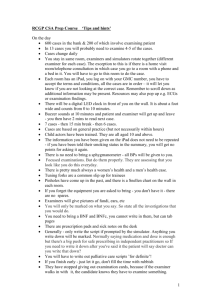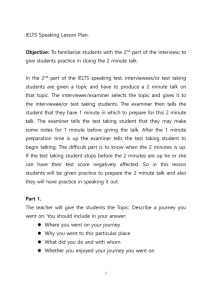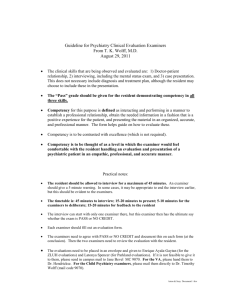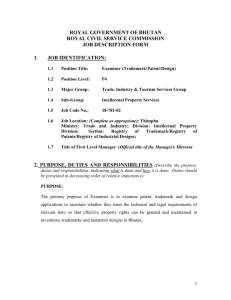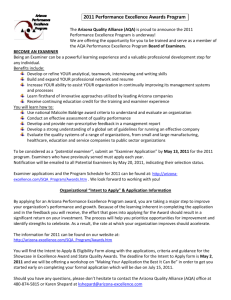O A I
advertisement
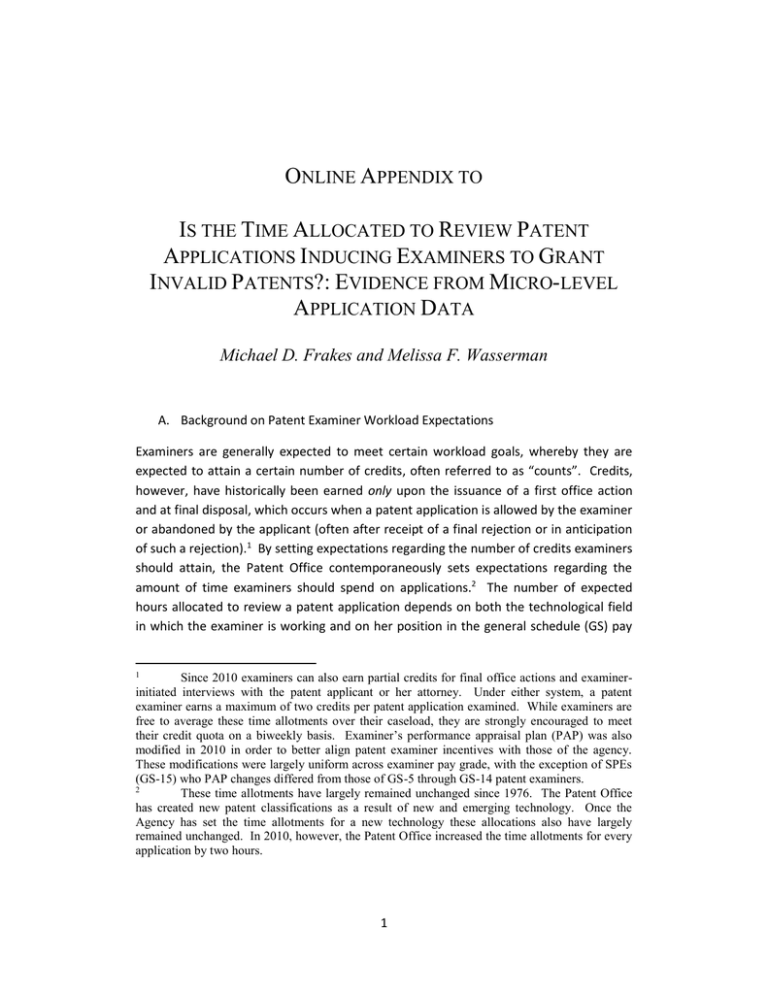
ONLINE APPENDIX TO IS THE TIME ALLOCATED TO REVIEW PATENT APPLICATIONS INDUCING EXAMINERS TO GRANT INVALID PATENTS?: EVIDENCE FROM MICRO-LEVEL APPLICATION DATA Michael D. Frakes and Melissa F. Wasserman A. Background on Patent Examiner Workload Expectations Examiners are generally expected to meet certain workload goals, whereby they are expected to attain a certain number of credits, often referred to as “counts”. Credits, however, have historically been earned only upon the issuance of a first office action and at final disposal, which occurs when a patent application is allowed by the examiner or abandoned by the applicant (often after receipt of a final rejection or in anticipation of such a rejection).1 By setting expectations regarding the number of credits examiners should attain, the Patent Office contemporaneously sets expectations regarding the amount of time examiners should spend on applications.2 The number of expected hours allocated to review a patent application depends on both the technological field in which the examiner is working and on her position in the general schedule (GS) pay 1 Since 2010 examiners can also earn partial credits for final office actions and examinerinitiated interviews with the patent applicant or her attorney. Under either system, a patent examiner earns a maximum of two credits per patent application examined. While examiners are free to average these time allotments over their caseload, they are strongly encouraged to meet their credit quota on a biweekly basis. Examiner’s performance appraisal plan (PAP) was also modified in 2010 in order to better align patent examiner incentives with those of the agency. These modifications were largely uniform across examiner pay grade, with the exception of SPEs (GS-15) who PAP changes differed from those of GS-5 through GS-14 patent examiners. 2 These time allotments have largely remained unchanged since 1976. The Patent Office has created new patent classifications as a result of new and emerging technology. Once the Agency has set the time allotments for a new technology these allocations also have largely remained unchanged. In 2010, however, the Patent Office increased the time allotments for every application by two hours. 1 scale. A patent examiner in a more complex field is allocated more hours to review an application than an examiner of the same grade who is working in a less complex field. The higher the pay grade of an examiner within a technology area the fewer number of hours the Patent Office allocates to earn two credited work units. B. Background on Collection of Rejection Types in USPTO PAIR Data Through reading of a number of office actions in the PTO PAIR data, we identified the following phrases that were either (1) likely to be associated with the examiner rejecting a claim as failing to meet the patentability standards, (2) likely to be associated with the examiner objecting to the form of the claim (as distinguished from its substance), (3) likely to be associated with an examiner objecting to other aspect of the application or making additional requirements of the patentee (e.g., objection to drawings, objection to the abstract, restriction requirement, etc.). To be clear, the focus of this article is claim rejections not objections. However, for completeness we reproduce the list of phrases we searched, including phrases that are directed only at identifying objections, below. rejected under; rejected are under; rejected as unpatentable; as being unpatentable; rejected as failing to define; objected to; election of species; fails to define a statutory; antecedent basis; new title is required; title of the application will; notice to comply; part of paper; prior art made of record and; rejected as being based; rejected as being directed; rejected on the ground; restriction to one of the fol; restriction is required under; status identifiers; fail to meet; fail to comply; fail to contain; fail to provide; fail to identify; fail to include; do not comply with; not in accordance with; cannot be patented; defective because; non-compliant because; renders the claim indefinite; not of sufficient quality; filed after the issue fee was; filed after publication; drawings in compliance with; declaration is missing; are not consistent; is not a proper submission; not include a support; claim rejections; this is a provisional obvious; because it is unsigned; not filed a certified copy; is non-responsive; required to furnish; introduce new matter; not contain a concise explan; the following omission; request for information; requirement for information; abstract exceeds 150 words; elect a single disclosed spec; elect disclosed species; not properly annotated; not signed by an; not authorized to sign; not 2 been submitted; not appear to be relevant to; non-elected subject matter in; terminal disclaimer needs to; associate poa are no longer; include common ownership as; other copending United States; application conflict with cla; contain every element of cla; believed to interfere; has not been met; not indicated the appropria; contain(s) every element of; claimed invention is differe; contains every element of cl; declaration in compliance wi; does not have publication da; do not have corresponding pa; filed well after the applica; list of all patents. Publica; notice of non-compliant amen; reference relevant to the ex; required information for the; requires that the summary of; restriction is hereby require; the appropriate statement ac; Website is not considered a. After compiling this list of phrases we then searched for approximate matches to each of the above listed phrases in office actions. Once such a match was identified we captured (or excerpted) the matched phrase and a small amount of surrounding text (approximately the sentence that contained the phrase). After this list of excerpts was compiled, we wrote a simple program that allowed us to perform an iterative procedure to match an excerpt containing a phrase listed above to a specific rejection type (e.g., 101, 102, 103, etc.) or objection type (e.g., 37 C.F.R. 1.121(d)). The program began by displaying all excerpts containing a phrase listed above that had not yet been assigned to a rejection or objection type. By inspection of this list, we choose a string of text (e.g., “35 USC 103”) appearing in at least one excerpt that ought to be associated with a particular rejection type (e.g., obviousness). We then identified all excerpts containing an exact match of the string of text that also contained a match to the same phrase listed above and assign each of them to the identified rejection or objection type. That is, each time we matched rejection or objection type to an excerpt we did so for only for that group of excerpts containing the same above-listed phrase (e.g., “rejected under,” “rejected are under,” etc.). We continued this iterative process until there were no more unassigned excerpts. B. Supplementary Notes Regard Data Collection Our sample includes all 1,956,493 utility applications that were filed on or after March 2001 and were published in the PAIR database by July 2012.3 By the end of 2012, 49 3 In November 2000, there was a change in the law that required newly filed patent applications to be published 18 months after they were filed. 35 U.S.C. § 122(b). Applicants abandoned within the first 18 months of filing, Id. § 122(b)(2)(A)(i) and applications wherein the applicant filed a special exemption to maintain confidentiality are exempted from this 3 percent of these applications had resulted in patents, 25 percent were not patented because they had been abandoned by the applicant,4 and the remainder were still pending. Applicants may elect to abandon their applications when they are unable to overcome an examiner’s rejection or for other business-related reasons. Our study focuses on the 1.4 million utility applications filed from 2001 onwards that received a final disposition—those that were granted of abandoned—by July, 2012. Critical to our analysis is determining the experience (in years) and the GS-level for each of the 9,000 examiners represented in our sample. For these purposes, we match the examiner field in the PAIR data with the two sets of examiner rosters received pursuant to separate FOIA requests. In order to calculate the relevant examiner’s experience, we take the difference between the year at the time of disposal of the application and the first year at which the examiner joined the Patent Office, as determined by observing when each examiner was first represented in annual examiner lists that we received from the Patent Office. To ensure that this approach accurately captures the experience of long-tenure examiners, we began collecting these annual rosters in 1992—that is, nearly ten years prior to the commencement of our sample period. Naturally, this cannot ensure complete precision in the experience assignment given that some examiners may have joined the Patent Office long before 1992 (making it difficult to distinguish between 10-year examiners and 20-year examiners for those applications disposed of in 2002). To alleviate these final censoring concerns, we simply focus the empirical analysis on those examiners who joined the Office in 1993 and beyond, though the results are entirely robust to disregarding this restriction (available upon request). On average, this restricted set of examiners stays at the Patent Office for roughly 6.8 years with roughly 25 percent of such examiners staying at least 10 years. Pursuant to a second FOIA request, we received an additional set of annual rosters from 2001 to 2012 indicating the GS level associated with each examiner on staff over those years. Furthermore, a third and final FOIA request allowed us to determine requirement, Id. § 122(b)(2)(B)(i). Such applications are thus absent from the PAIR database. When some or all of an applicant’s claims are not allowed by the Patent Office, the aggrieved party will sometimes file a continuation application. This application is given a new serial number and may be assigned to a different examiner. Continuation applications are treated as unique applications in the PAIR database. A related and now far more commonly used device, known as a Request for a Continued Examination (RCE), does not receive a new application serial number and effectively allows an aggrieved applicant to keep the application on the examiner’s docket for further prosecution. RCEs are not treated as new, unique filings in the PAIR database; rather, they are treated as a continuation in the prosecution of original applications. 4 A small portion of these applications were actually abandoned after being allowed by the examiner. 4 whether GS-13 examiners did or did not have partial signatory authority at that time, a distinction, as above, that bears on the hours allocated to the examiner for review. 5 The examiner field in PAIR had a number of typographical errors and variations in the spelling or formatting of names, complicating efforts to perform the above matches. To overcome this difficulty, we utilized the reclink Stata module, a “fuzzy” matching program designed to deal with variations in names over time (e.g., inclusions of full middle names versus middle initials, name changes upon marriage, etc.). Having performed this match, we then ensured the creation of a stable set of examiner field effects. All told, our analytical file contained roughly 9,000 examiners. In Columns 1 of Table A1, we set forth the percentage of applications in our sample that are disposed of by examiners in each of the relevant GS-levels and experience groups. Examiners spend considerably more time in higher GS ranges, especially GSlevel 14, thus accounting for the higher percentage of applications associated with high GS-level examiners. Also contributing to the relatively weaker presence of GS-levels 7 and 9 in the data is the fact that many examiners (nearly 1/3 of new examiners) begin at GS-level 11. In Column 2, we further illuminate this breakdown by taking all of the examiner rosters over the 2002–2012 period and indicating what percentage of these total examiner years were represented by examiners in the various GS-level and experience categories. For the reasons just discussed, this representation also tends to be weighted near the higher GS ranges. Finally, we exclude those few applications—roughly 3 percent of the raw sample— examined by individuals at GS-15 given uncertainty over the examination time allocated to those reaching this final, largely supervisory level from our sample. Published time allocation schedules suggest that GS-15 examiners should receive 67 or 71 percent of the time extended to their GS-12 counterparts. However, the specific time allocation amounts that we received from the PTO for each GS-15 examiner in our sample differ markedly and erratically from this generally published schedule.6 In any event, as 5 There were slight inconsistencies in the treatment of within-year promotions between the examiner roster data employed above and the secondary roster of GS-13 examiners we received pursuant to our second FOIA request. That is, many of those examiners receiving this within-GS13 promotion were registered as doing so during the year in which our primary roster indicated that they ascended to GS-level 14. We give priority to the timings of promotions set forth in this secondary data source. 6 Hoping that the difference in time allotments to GS-15 examiners would provide another within-GS-level degree of variation, we filed an additional FOIA request with the PTO asking for the specific examination-time allotments associated with each GS-15 examiner, for each year from 2002-2012. The provided data, however, list the majority of such GS-15 examiners as having the same amount of time allocated to GS-12 and GS-13 examiners, as opposed to the anticipated 67 percent and 71 percent values. In the Online Appendix, we estimate specifications that treat all 5 demonstrated by the Online Appendix, our results are robust to likewise tracking changes in grant rates upon the ascension to GS-15. On a final note, we exclude 2001 from our analytical sample, since the PAIR database only began collecting application data for filings commencing in March of 2001, leaving very few final dispositions of such applications in 2001 and thus leaving us with a weak ability to assess the determinants of granting decisions at such time (after all, patent prosecution durations are generally longer than a year). Similarly, we note that only 0.2 percent of the original sample were examined by GS-5 examiners. Given such a small level of representation, we exclude these applications from the analysis, though again we note that this exclusion is of little significance to our findings. TABLE A1: REPRESENTATION OF GS-LEVEL AND EXPERIENCE GROUPS (1) GS-level & Experience Group Percentage of Applications Disposed of by Examiner in Indicated Group (%) GS-7 GS-9 GS-11 GS-12 GS-13 GS-13, partial signatory GS-14 0-1 Years 2-3 Years 4-5 Years 6-7 Years 8-9 Years 10-11 Years 12-13 Years 14+ Years 1.8 5.7 9.9 13.6 19.2 15.3 34.5 8.8 15.2 15.9 12.8 10.7 10.8 10.1 15.7 (2) Percentage of Total Examiner Years Spent in Indicated Group Between 2002 and 2012 (%) 5.0 9.9 12.1 13.4 17.1 12.3 30.1 19.8 19.0 15.7 11.6 7.6 8.6 6.7 11.0 GS-15 examiners alike under the assumption, as expected from their published schedule, that GS15 examiners would receive even less time than their GS-14 counterparts. However, the uncertainties in the data received pursuant to this final FOIA request leaves us inclined to treat this as a supplementary exercise only. 6 Additional Robustness Checks 0.00 0.10 0.20 0.30 0.40 Figure A1: Relationship between Examiner Experience and Grant Rates, without Examiner Fixed Effects 0-1 Yrs 2-3 Yrs 4-5 Yrs 6-7 Yrs 8-9 Yrs 10-11 Yrs 12-13 Yrs 14+ Yrs Group Relative Grant Rate: Confidence Internval Relative Grant Rate: Mean Notes: this figure presents estimated coefficients of a regression of the incidence of the application being granted on a set of dummy variables capturing various experience groups (in years) of the relevant examiner. This figure also includes year fixed effects, but does not include examiner fixed effects or controls for the GS-level of the examiner. Standard errors are clustered at the examiner level. 7 0.00 0.10 0.20 0.30 0.40 Figure A2: Relationship between Examiner Experience and Grant Rates, including Indicator for Long-Tenure Examiner (>= 5 Years with Agency), without Examiner Fixed Effects 0-1 Yrs 2-3 Yrs 4-5 Yrs 6-7 Yrs 8-9 Yrs 10-11 Yrs 12-13 Yrs 14+ Yrs Group Relative Grant Rate: Confidence Internval Relative Grant Rate: Mean Notes: this figure replicates that of Figure A1, but includes a control for whether the examiner associated with the relevant application ultimately stays with the Agency for at least five years (following Lemley and Sampat, 2012). 8 0.00 0.10 0.20 0.30 Figure A3: Relationship between Examiner Experience and Grant Rates, including Indicator for Long-Tenure Examiner (>= 10 Years with Agency), without Examiner Fixed Effects 0-1 Yrs 2-3 Yrs 4-5 Yrs 6-7 Yrs 8-9 Yrs 10-11 Yrs 12-13 Yrs 14+ Yrs Group Relative Grant Rate: Confidence Internval Relative Grant Rate: Mean Notes: this figure replicates that of Figure A1, but includes a control for whether the examiner associated with the relevant application ultimately stays with the Agency for at least ten years (following Lemley and Sampat, 2012). 9 -0.05 0.00 0.05 0.10 Figure A4: Relationship between Examiner Experience and Grant Rates, with Examiner Fixed Effects 0-1 Yrs 2-3 Yrs 4-5 Yrs 6-7 Yrs 8-9 Yrs 10-11 Yrs 12-13 Yrs 14+ Yrs Group Relative Grant Rate: Confidence Internval Relative Grant Rate: Mean Notes: this figure replicates that of Figure A1, but includes a set of examiner fixed effects. 10 0.00 0.05 0.10 0.15 Figure A5: Relationship between Examiner GS-Level and Grant Rates, Restricted Duration-Window Approach GS-7 GS-9 GS-11 GS-12 Grade Relative Grant Rate: Confidence Internval GS-13 (1) GS-13 (2) GS-14 Relative Grant Rate: Mean Notes: this figure presents estimated coefficients of a regression of the incidence of the application being granted on a set of dummy variables capturing the incidence of the relevant examiner falling into each general schedule pay grade. This figure also includes year fixed effects and examiner fixed effects. The sample is limited to those applications that reach a disposition within three years from filing and that were filed in 2004 and beyond. Standard errors are clustered at the examiner level. 11 -0.10 0.00 0.10 0.20 0.30 Figure A6: Relationship between Grant Rates and Experience Years within Distinct Grade Levels, Including GS-15 GS-12 GS-13 (1) GS-13(2) GS-14 GS-15 Grade Level / Experience Group (2-Year Increments within each Level) Relative Grant Rate: Confidence Internval Relative Grant Rate: Mean Notes: this figure replicates that of Figure 3 in the text except that it includes examiners at GS-15. 12 -0.05 0.00 0.05 0.10 Figure A7: Relationship between Obviousness Rejection Share and Experience Years within Distinct Grade Levels, Including GS-15 GS-12 GS-13 (1) GS-13(2) GS-14 GS-15 Grade Level / Experience Group (2-Year Increments within each Level) Relative Obviousness Rejection Share: Confidence Internval Relative Obviousness Rejection Share: Mean Notes: this figure replicates that of Figure 5 in the text except that it includes examiners at GS-15. 13 0 .1 .2 .3 .4 .5 Figure A8: Relationship between Incidence of each of Section 101, Section 102, Section 103 and Section 112 Rejections and Examiner GS-Level (Percentage Results) GS-7 GS-9 GS-11 GS-12 Grade GS-13 (1) Section_101 Section_102 Section_112 Section_103 GS-13 (2) GS-14 Notes: this figure presents three sets of regression results. Each line represents the estimated mean coefficients of a regression of the incidence of the indicated rejection type on set of dummy variables capturing the incidence of the relevant examiner falling into each general schedule pay grade along with a set of dummy variables capturing the various experience groups (in years) of the relevant examiner. Coefficients are scaled by the mean incidence of each rejection type to facilitate an interpretation of this trend in percentage terms. This figure also includes year fixed effects and examiner fixed effects. Standard errors are omitted. 14 -.05 0 .05 .1 .15 .2 Figure A9: Relationship between Incidence of each of Section 101, Section 102, Section 103 and Section 112 Rejections and Examiner GS-Level (Percentage Results), Controlling for Application Characteristics and Technology-by-Year Fixed Effects GS-7 GS-9 GS-11 GS-12 Grade GS-13 (1) Section_101 Section_102 Section_112 Section_103 GS-13 (2) GS-14 Notes: this figure replicates that of Figure A8, but it includes controls for application entity size and prosecution duration, along with a full set of technology-by-year fixed effects. 15 -.02 0 .02 .04 .06 Figure A10: Relationship between Incidence of each of Section 101, Section 102, Section 103 and Section 112 Rejections and Examiner GS-Level (Percentage-Point Results), Controlling for Application Characteristics and Technology-by-Year Fixed Effects GS-7 GS-9 GS-11 GS-12 Grade GS-13 (1) Section_101 Section_102 Section_112 Section_103 GS-13 (2) GS-14 Notes: this figure replicates that of Figure A9, but it does not scale the coefficients by the mean incidence of the relevant rejection. . 16 0.20 0.10 0.00 Relative to GS-Level 7, Logged 0.30 Figure A11: Relationship between Number of Applicant-Provided Citations in Final Patents (Logged) and Examiner GS-Level GS-7 GS-9 GS-11 GS-12 Grade Relative Applicant Prior Art Citations: Confidence Internval GS-13 (1) GS-13 (2) GS-14 Relative Applicant Prior Art Citations: Mean Notes: this figure presents estimated coefficients of a regression of the number of applicant-provided citations (logged) on a set of dummy variables capturing the incidence of the relevant examiner falling into each general schedule pay grade along with a set of dummy variables capturing the various experience groups (in 2 year bins) of the relevant examiner. This figure also includes year fixed effects and examiner fixed effects. Standard errors are clustered at the examiner level. 17 0.05 0.00 -0.05 Relative to GS-Level 7, Logged 0.10 0.15 Figure A12: Relationship between Number of Examiner-Provided Citations in Final Patents (Logged) and Examiner GS-Level GS-7 GS-9 GS-11 GS-12 Grade Relative Examiner Prior Art Citations: Confidence Internval GS-13 (1) GS-13 (2) GS-14 Relative Examiner Prior Art Citations: Mean Notes: this figure replicates that of Figure A11 except that the dependent variable is the number of examiner-provided citations (logged). 18 Treatment of Examiners who Leave Agency and Return We note that 5 percent of the examiners in our sample left the Agency at some point only to return at a later point in time. With the possibility that this hiatus from the Agency may disrupt the learning / interruption story hypothesized in the text, we estimate alternative specifications that simply drop these examiners. The results are virtually identical in this alternative specification (results available upon request from the authors). Balanced Sample Analysis: Estimations using Select Sample of Examiners Consistently Present over Estimated Time Periods / Grade-Level Changes Estimating balanced-sample counterparts to Figure 3 in the text is tricky insofar as it is not possible to follow individual examiners over the entire course of years set forth in the figure given that (1) we are only following examiners over a 10-year period, as opposed to the longer period implicitly depicted in Figure 4 and (2) it is rare to find an examiner that stayed for a long period of time in every single grade. Nonetheless, in this Online Appendix, we also estimate a series of specifications that at least use balanced samples to estimate portions of Figure 4. For instance, to explore the robustness of the distinct jump in grant rates as we move from GS-13 (with signatory authority) to GS-14, we take a sample of those individuals who stay at GS-13 (with signatory authority) for at least 2 years before being promoted to GS-14 (we have also estimated balanced samples using longer time periods and may provide those results upon request, though sample sizes diminish considerably as we impose long tenures within GS-12 and GS-13). We then estimate a similar specification on these select (yet balanced) examiners only, focusing on the following time periods” 0-1 Years at GS-13(2) (the omitted category), 2+ Years at GS-3(2) and 0-1 Years at GS-14. We do similar exercises for each of the jumps depicted in Figure 4 in the text. In the case of the move from GS-13(2) to GS-14 and from GS-13(1) to GS-13(2), we estimate a distinct jump in grant rates upon the promotion itself that does not appear to be reflective of a pre-existing time trend while operating at those pre-promotion grade levels. However, rather than documenting a decline in grant rates over the time dimension, these specifications find flatness in granting tendencies over time followed by jumps in grant rates upon the relevant promotion, nonetheless 19 consistent with expectations. With respect to the move from GS-12 to GS-13(1), we continue to document a jump in grant rates upon the promotion, but we also find an increase in grant rates over the first two years while at GS-12, which is actually consistent with Figure 4 itself. TABLE A4: ESTIMATES OF WITHIN-GRADE CHANGES IN GRANT RATES OVER TIME AND SUBSEQUENT JUMPS UPON GRADE-LEVEL CHANGES, FOCUSING ON SEPARATE BALANCED SAMPLES OF EXAMINERS Panel A: following balanced sample of examiners who stay at GS-13 (with partial signatory authority) for 2+ years and subsequently ascend to GS-14. Omitted category: 0-1 Years at GS-13(2) 0.010 (0.007) 2+ Years at GS-13(2) 0.034*** (0.006) 0-1 Years at GS-14 N 97585 Panel B: following balanced sample of examiners who stay at GS-13 (without partial signatory authority) for 2+ years and subsequently ascend to GS-13(2) (with partial signatory authority). Omitted category: 0-1 Years at GS-13(1) 0.004 2+ Years at GS-13(1) (0.008) 0.030*** (0.010) 0-1 Years at GS-13(2) N 78224 Panel C: following balanced sample of examiners who stay at GS-12 for 2+ years and subsequently ascend to GS-13 (without partial signatory authority). Omitted category: 0-1 Years at GS-12. 2+ Years at GS-12 0.056*** (0.010) 0-1 Years at GS-13(1) 0.081*** (0.011) N 56533 * significant at 10%; ** significant at 5%; *** significant at 1%. Standard errors are reported in parentheses and are clustered to correct for autocorrelation within individual examiners over time. In the specification estimated in each panel, we regress the incidence of the application being granted on a series of dummy variables capturing specific experience years within each grade level, focusing in Panel A, for instance, on GS13 examiners with partial signatory authority and GS-14 examiners. We track examiners in Panel A for 0-1 and 2+ years within GS-13(2) and then for the first 2 years within GS-14, allowing for an observation of the jump in grant rates upon promotion to GS-14. To achieve balance in this exercise, we focus only on those examiners who (1) stay at GS-13 (with partial signatory authority) for at least 2 years and (2) then ascend to GS-14. Panels B and C conduct similar exercises for the indicated groups. Specifications include both examiner and year fixed effects. 20 21
